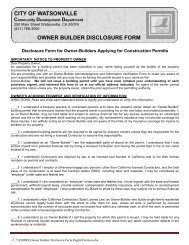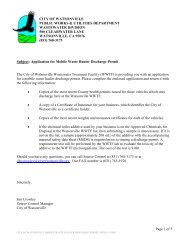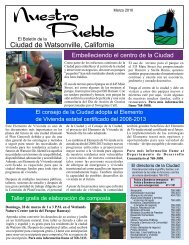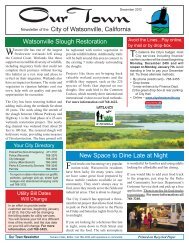Vegetation Management and Maintenance Plan - Watsonville ...
Vegetation Management and Maintenance Plan - Watsonville ...
Vegetation Management and Maintenance Plan - Watsonville ...
You also want an ePaper? Increase the reach of your titles
YUMPU automatically turns print PDFs into web optimized ePapers that Google loves.
HARDING GRASS<br />
Phalaris aquatica<br />
REED CANARY GRASS<br />
P. arundinaceae<br />
DISTINCTIVE FEATURES These two perennial grasses are distinguished<br />
by their gray-blue leaves <strong>and</strong> dense, spike-like flowering<br />
heads. The plant grows from deep, spreading rhizomes, forming a<br />
dense, waist-high thicket.<br />
BLOOMS Grass heads, March - September.<br />
PREFERRED HABITAT Forms spreading patches in wet soil conditions.<br />
Spreads by seed <strong>and</strong> underground stems. Native to the Mediterranean<br />
region, it is widespread in California since it is used for forage<br />
<strong>and</strong> withst<strong>and</strong>s heavy grazing.<br />
BRISTLY OX-TONGUE<br />
Picris echioides<br />
DISTINCTIVE FEATURES This plant grows as a biennial herb, 1-3<br />
feet tall. The species has erect branched stems, arising from a basal<br />
rosette. The leaves are bristly, with a rough, s<strong>and</strong>paper-like texture<br />
<strong>and</strong> clasp the. The flower heads are 1” wide in terminal heads.<br />
BLOOMS Yellow, April - December.<br />
PREFERRED HABITAT Bristly ox-tongue is common in coastal<br />
grassl<strong>and</strong>s <strong>and</strong> previously disturbed areas, where it can forms dense<br />
infestations. It spreads by seed, forming a rosette in year 1, with flowering<br />
<strong>and</strong> seed set in the 2 nd year. Native to the Mediterranean region.
















